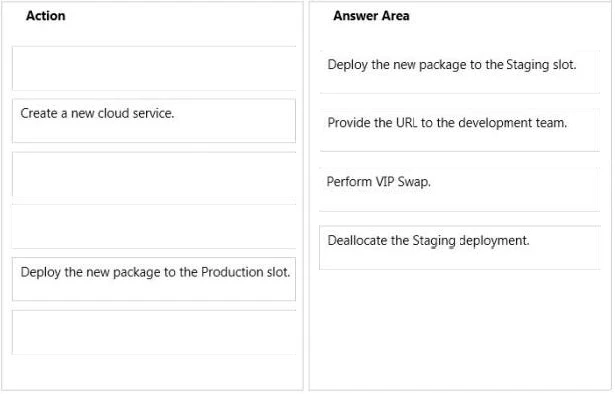Question 6 of 246
You manage a cloud service that has a web application named WebRole1. WebRole1 writes error messages to the Windows Event Log.
Users report receiving an error page with the following message: "Event 26 has occurred. Contact your system administrator."
You need to access the WebRole1 event log.
Which three actions should you perform? Each correct answer presents part of the solution.
Users report receiving an error page with the following message: "Event 26 has occurred. Contact your system administrator."
You need to access the WebRole1 event log.
Which three actions should you perform? Each correct answer presents part of the solution.
Correct Answer: A, C, F
Question 7 of 246
DRAG DROP -
You manage an application hosted on cloud services. The development team creates a new version of the application. The updated application has been packaged and stored in an Azure Storage account.
You have the following requirements:
✑ Deploy the latest version of the application to production with the least amount of downtime.
✑ Ensure that the updated application can be tested prior to deploying to the Production site.
✑ Ensure that the original version of the application can be restored until the new version is verified.
Which four steps should you perform in sequence? To answer, move the appropriate actions from the list of actions to the answer area and arrange them in the correct order.
Select and Place:

You manage an application hosted on cloud services. The development team creates a new version of the application. The updated application has been packaged and stored in an Azure Storage account.
You have the following requirements:
✑ Deploy the latest version of the application to production with the least amount of downtime.
✑ Ensure that the updated application can be tested prior to deploying to the Production site.
✑ Ensure that the original version of the application can be restored until the new version is verified.
Which four steps should you perform in sequence? To answer, move the appropriate actions from the list of actions to the answer area and arrange them in the correct order.
Select and Place:

Correct Answer:
Once you have uploaded the compiled package to Azure Storage, you would create a new staging deployment. You can then provide the URL to the development team. Once approved, you would promote the new deployment to production by performing a VIP swap. You can then stop the instance of the old production deployment and keep it at hand in the staging slot.
References:
http://msdn.microsoft.com/en-us/library/ff803371.aspx
References:
http://msdn.microsoft.com/en-us/library/ff803371.aspx

Question 8 of 246
You manage a cloud service that utilizes data encryption.
You need to ensure that the certificate used to encrypt data can be accessed by the cloud service application.
What should you do?
You need to ensure that the certificate used to encrypt data can be accessed by the cloud service application.
What should you do?
Correct Answer: A
Question 9 of 246
You administer a Windows Server virtual machine (VM).
You upload the VM to Azure.
You need to ensure that you are able to deploy the BGInfo and VMAccess extensions.
What should you do?
You upload the VM to Azure.
You need to ensure that you are able to deploy the BGInfo and VMAccess extensions.
What should you do?
Correct Answer: C
Question 10 of 246
You manage a cloud service that supports features hosted by two instances of an Azure virtual machine (VM).
You discover that occasional outages cause your service to fail.
You need to minimize the impact of outages to your cloud service.
Which two actions should you perform? Each correct answer presents part of the solution.
You discover that occasional outages cause your service to fail.
You need to minimize the impact of outages to your cloud service.
Which two actions should you perform? Each correct answer presents part of the solution.
Correct Answer: B, D